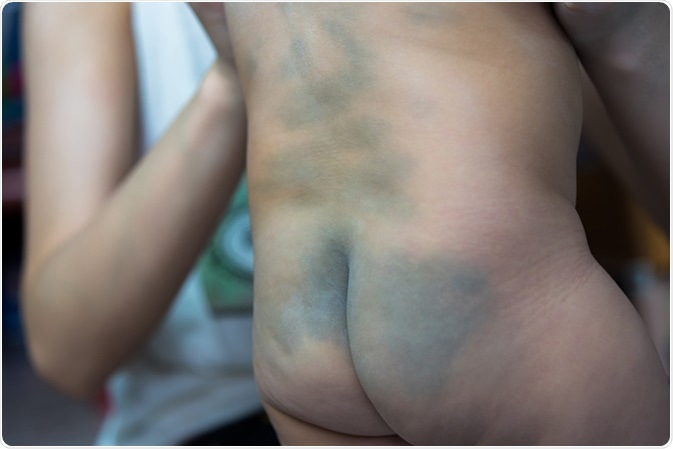Birthmarks: Vascular and Pigmented

Birthmarks are marks present on the skin from birth. They are mainly of two types: vascular and pigmented.

Vascular Birthmarks
These result from abnormalities in the formation of blood vessels, which form clumps under the skin or in deeper layers of the body. They are usually various shades of red or pink due to the color of the blood vessel, so two common types of vascular birthmarks are called strawberry hemangiomas and port-wine stains.
Salmon patches are hemangiomas which are pink or red. They are also called angels’ kisses and sometimes stork bites when they occur on the face or the back of the neck respectively.
Strawberry hemangiomas look just like the fruit whose name they bear, and are soft to touch.
Port-wine stains are the color of grape juice and irregular in shape, being flush with the skin. Deeper hemangiomas are darker in color and may make the skin appear raised.
Most hemangiomas grow over the first year of life but slowly shrink thereafter to become flat by the age of ten years in most cases; however, a light residual mark is often found to persist.
Pigmented Birthmarks
A pigmented birthmark derives its color from an abnormal group of pigment cells in the skin. There can be various colors, from black to tan.
While many moles are small and round, some are large and have different colors. Moles may be either smooth and flush with the skin, or raised above the skin surface.
They may have a smooth or rough texture. Some commonly encountered moles are called by specific names, such as the café-au-lait spots which take their name from their typical light brown color, which looks like coffee to which milk has been added. With this said, some people have dark brown café-au-lait spots.
Mongolian spots are another common type of nevus which are bluish-grey in color, and are most common in darker-skinned children. They are usually present at birth and are seen over the back and the gluteal region.
Diagnosis and Treatment
While the etiology of most birthmarks is still unknown, some do have a familial association. Diagnosis is based upon the history and physical appearance.
While most birthmarks are only of cosmetic significance, some types of nevi are associated with an increased risk of skin cancer. Therefore a careful follow-up is mandatory for any nevus (pigmented birthmark) which changes color or size, or becomes pruritic or infected. A biopsy may be necessary to rule out malignant changes.
Treatment of these depends on the type of birthmark, as well as the presence of other worrisome conditions. It includes surgery or laser treatment.
Vascular birthmarks are also treated by laser coagulation of the offending blood vessels. Very large hemangiomas may require special make-up to mask them if they occur in visible areas.
References
- https://www.betterhealth.vic.gov.au/health/conditionsandtreatments/birthmarks
- https://medlineplus.gov/birthmarks.html
- https://www.aad.org/public/kids/skin/birthmarks/different-kinds-of-birthmarks
- http://www.racgp.org.au/afp/201205/46543
Further Reading
- All Birthmark Content
Last Updated: Feb 26, 2019

Written by
Dr. Liji Thomas
Dr. Liji Thomas is an OB-GYN, who graduated from the Government Medical College, University of Calicut, Kerala, in 2001. Liji practiced as a full-time consultant in obstetrics/gynecology in a private hospital for a few years following her graduation. She has counseled hundreds of patients facing issues from pregnancy-related problems and infertility, and has been in charge of over 2,000 deliveries, striving always to achieve a normal delivery rather than operative.
Source: Read Full Article